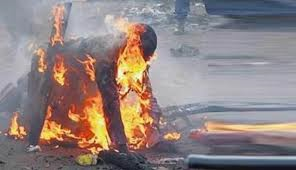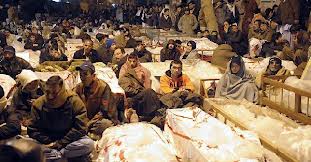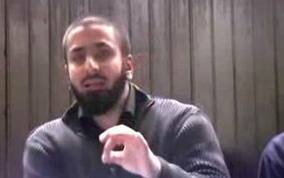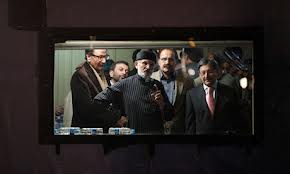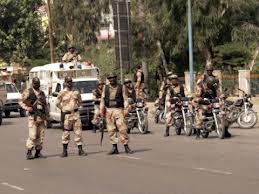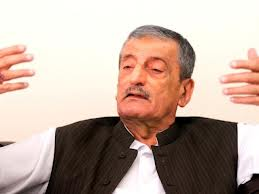
Although the Indian and Pakistan army patrols both sides of the Thar border, there is commonality between the religious groups that have stayed behind since 1947. The Tharis share grinding poverty — living as they do, in cone shaped huts, drinking shallow ground water and subsisting on wild plants and herbs. They are herders and growers in a small market economy, where there is little money to buy the goods found in the cities.
While much of Pakistan suffers from communal and sectarian killings, there is a sanctity for life in the desert. In Bhodesar, mosque and mandir (Hindu temple) coexist side by side, and are visited by people of both religions. In the mandir’s the Hindu way of life is present, with women praying indoors… while men play devotional songs in more open spaces. Water and food is shared among the creatures that live around; big dodo birds that are extinct elsewhere, mix with the common crows with impunity.
In Islamkot, there is a water fountain, where peacocks come to drink water in the early mornings and evenings, even as they sit on top of trees under the blazing sun.
It is in the poetry and songs sung by faqirs (dervishes) in undulating sands lit by the moon, that carries the message of peace between the communities. Whether it is the songs of Shah Abdul Latif Bhitai or Shaikh Ayaz, the intoxication with which the sufis render their songs, to the accompaniment of harmonium and drums, carries away listeners. The peacocks crying out from behind the veil of darkness seem to be as much part of the music troupe.
We witnessed one such performance near the desert’s border with India.. where a sturdy rows of lights were the only evidence of the division of Sindh. We had crossed the salty lowland that stretches to the Rann of Kutch… which was invaded by Indian troops in the 1965 war and only partially returned to Pakistan. It was a reminder of the territorial hostility that remains between the two neighbors. Lurching over ditches and marshes, our four wheel drive rumbled near the Indo Pak border and settled on the sands to hear musicians.
The verses I had heard earlier from our hosts came to mind,
“Hindu banay ga, na Musalman banay ga
Insaan ki aulad hai, insaan banay ga”
(You will be neither a Hindu, nor a Muslim
You are descended from a human, you will be a human)
But these ideals aside, it is the realpolitik of partition that dominates the reality for Hindus and Muslims on both sides. Over the last decade, the army transformed the Tharparkar desert from undulating sand dunes — formerly traversed by giant crab like vehicles — into a region accessible by metal roads. The roads from Mithi, Islamkot to Nangarparkar have brought security check posts and Rangers , and restrictions on cameras, laptops and other equipment.
In this border race, India has reportedly acquired more sophisticated equipment to monitor border activity. It is this technological race that is keeping Pakistan’s armed forces on its toes.
For the ordinary Tharis, life goes on as it might have centuries ago. As a local medical practitioner, Dr Khatau Mal puts it, new roads means that he now receives more victims of motor bike accidents as compared to snake bite. With endemic poverty, the doctor says the only reason more Hindus don’t migrate to India is that they are too poor to afford the journey.
Today, drinking water is still a precious commodity. Those with access to underground wells are lucky. The Tharis use donkeys, or people to turn pulleys.. tied with ropes to a bucket.. turning it clock wise and anti clockwise to draw water from the deep wells.
There is a well in Bhalva that would have been common place, but for the legend that it was the spot where Marvi filled water when Umar Soomro — the King of Umarkot — kidnapped her in the 14th century. That became the inspiration for Bhitai’s poetry of the young woman’s resistance to Umar’s wealth and power, and her success in eventually returning to her own people in Thar.
In the last three years, the heavy downpours in Sindh have changed the desert into large swathes of green. It has led to mushrooming of wild plants, which provide fodder for animals and food for people. The rains have left streams of water trickling down from the Karoonjhar hills – filling the dams and lakes below.
It is also the non governmental organizations that are starting to make a difference. Thardeep Rural Development Program is one such NGO that is putting down roots here. It has earmarked villages throughout the desert where people are being empowered to improve their access to water sources, education and the means of earning a livelihood.
The TRDP has a model rest house in Nangarparkar, which is already implementing environmentally friendly policies like using solar power, water conservation and local building materials. The impressive building – which opens up to the Karoonjhar hills – will have a convention center as well. It is a work in progress that promises to improve the quality of life for all the desert people.
Meanwhile, in a country wracked by sectarianism and intolerance , there is much to be learnt from Tharparkar. This “green desert,” that stretches to the Indian border, embodies the spiritual strength with which Sindh has learnt to deal with its adversities.


